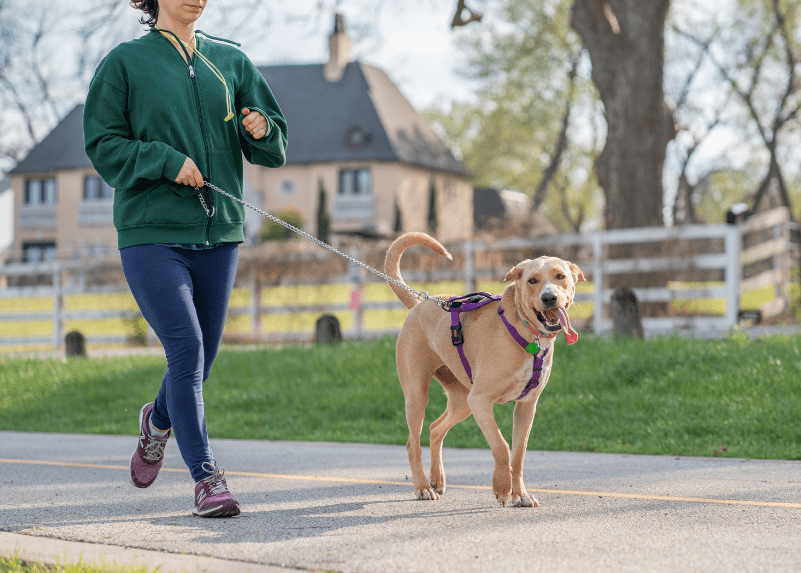This post contains affiliate links, we'll earn compensation if you make a purchase using them at no additional cost to you 😊
Understanding how often you should walk your dog is essential to learn about if you have a dog.
Also, it depends on multiple factors, like your dog’s breed, eating patterns, physique, and health.
Plus, the number of times you walk your dog depends on the amount of time you spend on one walk.
Here’s how each component weighs in when understanding how often you can walk your dog.
How Often Should You Really Walk Your Dog?
I take my dog on a walk 2-3 times a day for about 15-20 minutes. But, the average number of walks should depend on the factors like breed, eating patterns, size, strength, and health condition of the dog.

A single is suitable for small-sized dogs, but for big dogs & strong dogs, we recommend 2-4 walks a day.
Many dog owners are often confused about how much their dog should walk in a day. So, to clear this confusion out of dog owners’ minds, we‘ve analyzed a few components based on different types of dogs.
Thus, if you are a person who likes taking their dog out to play and exercise, don’t worry; we have got you covered.
Factors That Affect A Dog’s Walking Frequency
Your dog’s walking capacity depends on its breed (energy levels), eating habits or patterns, size, and health. These factors are vital in order to understand how long and how many times your dog can go on a walk.

Hence, you can refer to the following information when you are making a walking schedule according to your dog’s requirements and limitations.
1. Breed (high energy & low energy)
Your dog’s breed affects the dog’s walking capacity more than you think. It decides the dog’s size and capacity to exercise.
Sporty breeds like shepherds, collies, rottweilers, etc., have higher exercise requirements than lapdogs like chihuahuas, papillons, and other smaller breeds.
2. Eating patterns
Your dog’s eating pattern and habits affect its walking capacity just as much as other components related to dogs.
Dogs with meals full of nutrients and protein are usually physically more active than dogs with no healthy food intake.
3. Physique & Strength
A dog in good shape can go on 30-minute walks every day. Most of the breeds are super active, so that they may need walks multiple times a day.
Dogs with strong physiques don’t get tired easily after long and multiple walks. However, if your dog is weaker or undernourished, it will be exhausted after some exercise and walking.
4. Health conditions
Your dog’s health and medical conditions affect your dog’s stamina and ability to do any exercise.
If your dog has a medical condition, it can affect your dog’s ability and willingness to go on multiple walks. However, it changes with different health conditions.
How Long Should You Walk Your Dog?
Most dogs have the capacity to walk for about 20-30 minutes a day if they are in good shape. Some dogs with more muscular physiques can go on a 2-hour walk or hike.

Though, It is a little difficult for overweight dogs to walk more than 15 minutes without intervals and brakes.
To determine the actual duration your dog can walk up to, you can start by monitoring your dog’s energy level.
You can take your dog on a walk and supervise his energy level based on its health state after a while in the dog. You will understand if the dog is at an energetic pace or slowing down after some time.
If the dog’s still energetic after returning from the walk, then your dog can walk that much distance. But, if the dog slows down by the time you are back home, that means your dog has walked up to its limit.
How Does Walking Benefit Your Dog’s Health (And Yours, Too)?
Let’s talk about why walking your dog is important. Understandably, your dog regularly goes out to take a dump and pee. But you can also take your dog on walks which are just for fun and exercise purposes.

Walking your dog twice or thrice a day will definitely improve the relationship between you and your dog. It also helps your dog to learn socializing skills.
However, while walking, you can have fun with exercises to keep your dog and yourself healthy.
The benefits mentioned here apply to you along with your dogs. It helps you to achieve your fitness goals and your overall well-being.
Also, there are a lot of ways your dog can be benefitted just by walking, such as:
- Regular walking can help your dog maintain a healthy weight.
- Your dog’s joints will be in good shape if you take him on daily walks and exercises.
- Daily walks keep the dog’s digestive systems healthy and regular, along with their urinary health.
I’m sure owners who take their dogs on regular walks have already noticed these characteristics in their dogs’ routines.
High and Low Energy Breeds
There are two types of breeds in dogs. The high-energy breeds need more activity time, strength, and walking time. In contrast, low-energy breeds don’t require as much energy as high-energy dog breeds.
The following are a few examples of high-energy dog breeds:
- Australian Shepherd
- Border Collie
- Dalmatian
- Irish Setter
- Labrador Retriever
- Siberian Husky
- Rhodesian Ridgeback
- Weimaraner
These dogs are more suitable for taking on long walks and performing training activities. Hence, the perfect way to bond closely with these breeds is to go on outdoor adventures with them.
The following are a few examples of low-energy dog breeds:
- Bull Dogs
- Basset Hounds
- Great Danes
- Mastiffs
- Newfoundlands
- Pekingese
- Yorkshire Terriers
Now, in contrast to high-energy dogs, the low-energy dogs mentioned above don’t need that much energy and are more likely to rest at home.
Related Reads
Final Thoughts
The number of times you take your dog on a walk is up to your dog’s requirement. Also, we recommend taking your dog on a walk 2-3 times a day.
Taking your dog out often helps your dog to improve his socializing skills. Dogs become happier and healthier physically and mentally because of regular walks and exercise.
I hope you understand how many times you need to take your dog on a walk in a day in a better way.
Also, hopefully, this article was helpful to you in other aspects related to walking a dog too. So, let us know your feedback on this article in the comments below. Thank you for sticking to the end.
FAQs
The majority of dogs require 1-2 daily walks (unless otherwise stated by your veterinarian).
It’s not required for your dog to take a daily walk. Generally, it is nothing to worry about; however, walking helps your dog improve stamina.
Feeding a dog after a walk is usually recommended, but not right away. You should at least feed a dog 50-60 minutes after the walk.
Just like humans, dogs also get bored of the same routine of walks after a while.
Dogs require the brainy stimulation that comes from experiencing new things and sights.


